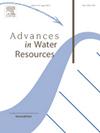深盐水含水层二氧化碳封存注入期和注入后的物理约束神经网络
IF 4
2区 环境科学与生态学
Q1 WATER RESOURCES
引用次数: 0
摘要
二氧化碳捕集与封存是减缓全球气候变化的一个可行解决方案。尤其是深层含盐地下蓄水层,由于其巨大的容量和广泛的分布,已成为前景广阔的封存选择。然而,在这些地层中熟练监测和模拟二氧化碳行为的任务提出了重大挑战。为了解决这个问题,我们引入了二氧化碳封存物理约束神经网络(CO2PCNet),这是一个专门用于模拟和监测深层含盐地下蓄水层中二氧化碳在注入期间和注入后的封存情况的模型。CO2PCNet 认识到在不同渗透率条件下精确模拟二氧化碳分布和移动所面临的巨大挑战,因此将物理学原理与深度学习的鲁棒性相结合,作为一个强大的替代模型。CO2PCNet 的架构从一个编码器开始,该编码器能够熟练地处理来自总体摩尔分数(zCO2)和压力场(Pl)的空间特征,捕捉二氧化碳轨迹的复杂动态。通过调节步骤将渗透性信息纳入其中,该网络可确保忠实地反映地下条件对二氧化碳行为的影响。ConvLSTM 模块随后会识别时间演变,反映储层中二氧化碳羽流的真实进展。最后,解码器可精确重建二氧化碳分布的预测空间轮廓。CO2PCNet 融合了卷积层、递归机制和物理约束,为二氧化碳封存模拟提供了一种完善的方法。该模型提供了利用先进计算方法推进二氧化碳封存实践的潜力。本文章由计算机程序翻译,如有差异,请以英文原文为准。
A physics-constraint neural network for CO2 storage in deep saline aquifers during injection and post-injection periods
CO2 capture and storage is a viable solution in the effort to mitigate global climate change. Deep saline aquifers, in particular, have emerged as promising storage options, owing to their vast capacity and widespread distribution. However, the task of proficiently monitoring and simulating CO2 behavior within these formations poses significant challenges. To address this, we introduce the physics-constraint neural network for CO2 storage (CO2PCNet), a model specifically designed for simulating and monitoring CO2 storage in deep saline aquifers during injection and post-injection periods. Recognizing the significant challenges in accurately modeling the distribution and movement of CO2 under varying permeability conditions, the CO2PCNet integrates the principles of physics with the robustness of deep learning, serving as a powerful surrogate model. The architecture of CO2PCNet starts with an encoder that adeptly processes spatial features from overall mole fraction () and pressure fields (), capturing the complex dynamics of a CO2 trajectory. By incorporating permeability information through a conditioning step, the network ensures a faithful representation of the influences on CO2 behavior in subsurface conditions. A ConvLSTM module subsequently discerns temporal evolutions, reflecting the real-world progression of CO2 plumes within the reservoir. Lastly, the decoder precisely reconstructs the predictive spatial profile of CO2 distribution. CO2PCNet, with its integration of convolutional layers, recurrent mechanisms, and physics-informed constraints, offers a refined approach to CO2 storage simulation. This model offers the potential of utilizing advanced computational methods in advancing CCS practices.
求助全文
通过发布文献求助,成功后即可免费获取论文全文。
去求助
来源期刊

Advances in Water Resources
环境科学-水资源
CiteScore
9.40
自引率
6.40%
发文量
171
审稿时长
36 days
期刊介绍:
Advances in Water Resources provides a forum for the presentation of fundamental scientific advances in the understanding of water resources systems. The scope of Advances in Water Resources includes any combination of theoretical, computational, and experimental approaches used to advance fundamental understanding of surface or subsurface water resources systems or the interaction of these systems with the atmosphere, geosphere, biosphere, and human societies. Manuscripts involving case studies that do not attempt to reach broader conclusions, research on engineering design, applied hydraulics, or water quality and treatment, as well as applications of existing knowledge that do not advance fundamental understanding of hydrological processes, are not appropriate for Advances in Water Resources.
Examples of appropriate topical areas that will be considered include the following:
• Surface and subsurface hydrology
• Hydrometeorology
• Environmental fluid dynamics
• Ecohydrology and ecohydrodynamics
• Multiphase transport phenomena in porous media
• Fluid flow and species transport and reaction processes
 求助内容:
求助内容: 应助结果提醒方式:
应助结果提醒方式:


